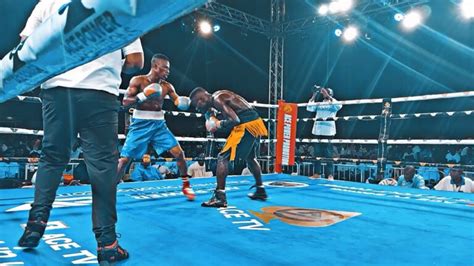Explore how technology transforms boxing training with wearable devices, virtual reality, data analytics, and AI to enhance performance and strategies for fighters.In the evolving world of athletics, boxing stands out as a sport where tradition meets innovation. The impact of technology on modern boxing training is transforming how fighters prepare, spar, and ultimately perform in the ring. Gone are the days when training relied solely on physical strength and intuition; today’s boxers harness cutting-edge tools and techniques to gain a competitive edge. From wearable devices that monitor performance to virtual reality experiences that enhance sparring sessions, technology is revolutionizing the way athletes engage with their sport. Data analytics further refines fighter strategies, making training regimens more efficient and effective. As we delve into the various facets of this technological transformation, we will explore how these advancements are shaping the future of boxing training and improving outcomes for fighters at all levels.
How Technology Revolutionizes Boxing Training Techniques
The integration of technology into boxing training has transformed traditional practices, making them more effective, engaging, and data-driven. The impact of these modern advancements can be felt across various training aspects, from technique refinement to injury prevention. Here are some key ways in which technology is revolutionizing boxing training techniques:
- Smart Equipment: Boxing gloves and punching bags equipped with sensors provide real-time feedback on punch speed, power, and accuracy. This data enables athletes to fine-tune their techniques and identify areas for improvement.
- Video Analysis: Using high-definition cameras, trainers can record fighters during training sessions. Analyzing these recordings with specialized software helps to assess form, movement, and strategy, allowing for tailored coaching.
- Motion Capture Technology: This technology enables trainers to analyze the biomechanics of a boxer’s movements. By studying the data collected, they can modify techniques to enhance performance and reduce the risk of injuries.
- Online Coaching Platforms: The rise of digital training platforms allows fighters and trainers to connect remotely. This innovation provides access to expert coaching, training plans, and nutritional guidance without the need for physical proximity.
- Augmented Reality (AR): AR tools are being used to simulate different fighting scenarios, allowing athletes to practice without a sparring partner. This immersive training method enhances visualization and prepares boxers for various in-ring situations.
Overall, technology is playing an ever-increasing role in enhancing the skills and performance of boxers. The impact of these advancements not only optimizes training efficiency but also ensures that fighters receive the best preparation possible for competition.
The Impact Of Wearable Devices On Performance Monitoring
The integration of technology into boxing training has significantly transformed how athletes monitor and enhance their performance. One of the most notable advancements is the use of wearable devices. These smart gadgets offer real-time feedback and data collection, allowing fighters to analyze their training sessions more effectively.
Wearable devices such as heart rate monitors, smartwatches, and advanced fitness trackers track various metrics including heart rate, calorie expenditure, and even punch speed. By collecting and analyzing this data, boxers can gain valuable insights into their training intensity and recovery times.
Moreover, the capability of wearable devices to monitor the impact of specific training routines enables boxers to customize their training plans according to their individual needs. For instance, if a fighter is consistently hitting a particular intensity level during sparring sessions, they can adjust their regimen to either increase or decrease their workload based on recovery needs.
This personalization is crucial as it not only helps in optimizing performance but also in reducing the risk of injuries by ensuring that athletes train within safe limits. Additionally, coaches and trainers can utilize data from these devices to make informed decisions about fight strategies and training adjustments, enhancing overall readiness for competition.
The adoption of wearables has led to a sophisticated approach to performance monitoring in boxing training. The ongoing development in this technology promises even greater benefits, making it an indispensable tool for modern-day boxers.
Virtual Reality: Enhancing Sparring Experiences
Virtual reality (VR) technology has made significant inroads into various sports, and boxing is no exception. By integrating VR into training routines, fighters can experience a simulation of real-life sparring without the physical toll that comes with traditional training methods. This technological advancement not only provides a safer training environment but also allows boxers to develop their skills in a controlled setting.
One of the most notable benefits of VR is the ability to create customizable sparring scenarios. Coaches can design specific drills that target a boxer’s weaknesses or emphasize particular techniques. This level of personalization allows for more tailored training sessions, ensuring that fighters are continuously challenged and engaged.
Furthermore, the immersive experience of VR helps boxers improve their reaction times and decision-making abilities. By simulating various fight environments and opponents, athletes can practice their strategies and tactics. This hands-on practice in a realistic setting significantly enhances their ability to adapt during an actual match.
As technology advances, we can expect VR to incorporate even more sophisticated features, such as AI-driven opponents that mimic the fighting styles of top competitors. This evolution will further enhance the training process, pushing fighters to refine their skills and stay competitive in the ever-evolving landscape of boxing.
The impact of virtual reality on boxing training is profound. It not only allows fighters to refine their techniques in a safe manner but also fosters strategic thinking, adaptability, and overall performance. As trainers and athletes begin to embrace this innovative tool, we can anticipate a new era of boxing training that is not only more effective but also safer and more engaging.
Data Analytics: Improving Fighter Strategy and Results
In the age of information, data analytics plays a critical role in enhancing performance in various sports, and boxing is no exception. The impact of data-driven insights can significantly shape a fighter’s training regimen, strategy, and overall performance in the ring.
By utilizing various data collection methods, trainer and fighter teams can track metrics such as punch frequency, accuracy, and defensive maneuvers. Analyzing this data allows them to identify strengths and weaknesses more effectively. Coaches can observe patterns that may emerge during training sessions and matches, thus tailoring strategies that maximize their fighters’ chances of success.
For example, data analytics can spotlight how a fighter responds to high-pressure scenarios, helping trainers create simulations that prepare their athletes for real in-ring challenges. Additionally, tracking recovery metrics can optimize training loads, ensuring fighters maintain peak physical condition without the risk of overtraining.
Moreover, the integration of video analysis software further enhances this process. Coaches can break down fights frame by frame, revealing critical insights into an opponent’s techniques and habits. This, in combination with raw data, allows for a comprehensive approach to strategizing, giving fighters a competitive edge.
As technology continues to evolve, the reliance on data analytics is only expected to grow. This trend not only underscores the impact of technology in modern boxing training but also emphasizes the importance of strategic development driven by detailed performance metrics.
Future Trends: The Impact Of AI In Boxing Training
As technology continues to advance, the integration of artificial intelligence (AI) into boxing training is becoming increasingly prevalent. This evolution holds significant promise for the sport, impacting both training methodologies and competitive performance. Here are some ways AI is expected to shape the future of boxing training:
- Personalized Training Regimens: AI can analyze an athlete’s performance data and create customized training programs tailored to their specific strengths and weaknesses. By providing dynamic adjustments based on real-time feedback, fighters can optimize their training sessions and maximize skill development.
- Performance Prediction: Machine learning algorithms can analyze vast amounts of historical performance data to predict potential outcomes for fighters based on their training regimens and matchup scenarios. This predictive analysis can aid coaches in strategizing effectively.
- Injury Prevention: With its ability to monitor biomechanics through wearable technology, AI can identify patterns that may lead to injuries. This role in injury prevention ensures that fighters can maintain their training schedules and stay healthy throughout their careers.
- Enhanced Video Analysis: AI-driven video analysis tools can break down fight footage to provide insights on an athlete’s technique, timing, and movement patterns. By highlighting areas for improvement, these tools facilitate targeted training interventions.
- Virtual Sparring Partners: Future advancements could lead to AI-driven virtual sparring partners, providing fighters with the ability to practice their skills against simulated opponents that can replicate different fighting styles. This provides an opportunity for fighters to refine techniques in a controlled environment.
The integration of AI into boxing training signifies a transformative impact on how athletes prepare for competition. As these technologies continue to evolve, fighters and coaches will have unprecedented tools at their disposal to enhance training efficacy and performance outcomes.
Frequently Asked Questions
How has technology changed the way boxers train?
Technology has introduced various tools and platforms, such as wearable fitness trackers, smart gloves, and digital platforms for virtual coaching, enabling more personalized and data-driven training regimens.
What are some examples of wearable technology used in boxing?
Examples include heart rate monitors, fitness trackers, and smart gloves that provide data on punch speed and force, helping boxers analyze and improve their performance.
How does video analysis enhance boxing training?
Video analysis allows trainers and athletes to break down techniques and strategies, identify weaknesses, and visually track progress over time, leading to more effective training sessions.
Can technology help prevent injuries in boxing training?
Yes, technology such as motion capture and biomechanics analysis can help identify improper techniques that may lead to injuries, allowing athletes to correct their form and reduce the risk.
What role do apps play in modern boxing training?
Apps provide access to training plans, nutrition tracking, fight simulations, and even virtual sparring, making it easier for boxers to stay organized and motivated.
How has social media affected boxing training and coaching?
Social media facilitates the sharing of training tips, techniques, and motivational content, allowing boxers to connect with a broader community and gain insights from various experts.
Are there any downsides to the reliance on technology in boxing training?
While technology enhances training, over-reliance may detract from fundamental skills and techniques. It’s important for athletes to maintain a balance between tech use and traditional training methods.










Thank you for this insightful article! I’m really interested in how technology is transforming sports training, especially boxing. I do wonder though, do you think there’s a risk that some fighters might become too reliant on these tech tools, losing the instinctive techniques that are crucial in the ring? It would be great to hear more thoughts on balancing traditional methods with high-tech training.